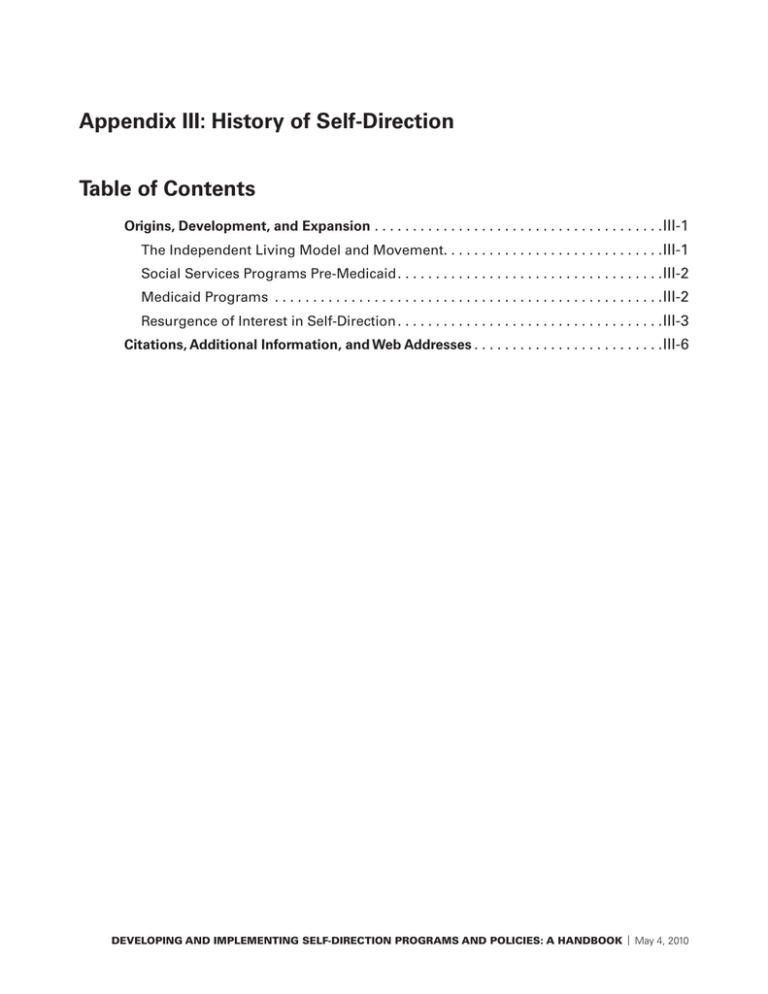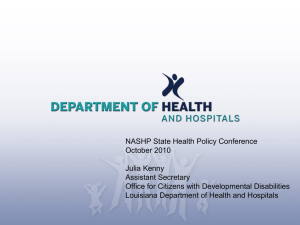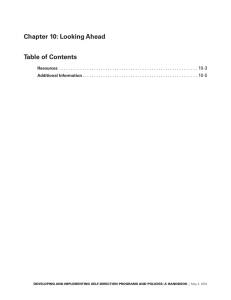Appendix III: History of Self-Direction Table of Contents III-1 III-2
advertisement

Appendix III: History of Self-Direction Table of Contents Origins, Development, and Expansion���������������������������������������������������������������������������� III-1 The Independent Living Model and Movement�������������������������������������������������������� III-1 Social Services Programs Pre-Medicaid�������������������������������������������������������������������� III-2 Medicaid Programs������������������������������������������������������������������������������������������������������ III-2 Resurgence of Interest in Self-Direction �������������������������������������������������������������������� III-3 Citations, Additional Information, and Web Addresses ������������������������������������������������ III-6 DEVELOPING AND IMPLEMENTING SELF-DIRECTION PROGRAMS AND POLICIES: A HANDBOOK | May 4, 2010 Appendix III—History of Self-Direction III-1 Appendix III History of Self-Direction1 Origins, Development, and Expansion The origins of self-directed personal assistance services (PAS) can be traced back more than 50 years. In 1953, Los Angeles County discovered that it could take care of the needs of its 158 iron lung users with polio at a cost of only $10 per day using personal assistants rather than paying $37 a day for inpatient care at the Rancho Los Amigos Medical Center.2 The Los Angeles County program eventually grew to become, in 1973, the statewide California In-Home Supportive Services (IHHS) program. At this time, the program was not a Medicaid program and was financed through a combination of county and state revenues and federal Title XX funding. Since 1993, IHSS has been funded with county, state, and federal funds, mainly through the Medicaid program. Whereas the original county program was only for polio survivors, IHSS has always served older persons, working age adults, and young children with a wide range of disabling physical and mental conditions. With over 300,000 participants, IHSS is the single largest public program providing the employer authority feature of self-direction.3 An early budget authority prototype was the Veteran’s Administration’s Attendant Care non-taxable “cash” benefit program established shortly after World War II for veterans with service connected disabilities. However, until the late 1990s, when the first Cash & Counseling Demonstration and Evaluation began, programs that allowed participants to manage a budget were rare. The Independent Living Model and Movement People with disabilities who benefited from early self-direction prototypes founded the Independent Living Movement in the 1960s and 1970s. One of them, Ed Roberts, started the Physically Disabled Students Program, which, among other activities, ran a self-direction attendant program at the University of California, Berkeley. In 1972, Roberts and others established a similar program for non-students with federal and private grant funding—the first Center for Independent Living (CIL). From the late 1970s to the early 1990s, the World Institute on Disability (WID) along with rehabilitative services professionals began to articulate the Independent Living model of self-directed personal assistance services as a set of philosophical principles that should guide public policy.4 DEVELOPING AND IMPLEMENTING SELF-DIRECTION PROGRAMS AND POLICIES: A HANDBOOK | May 4, 2010 III-2 Social Services Programs Pre-Medicaid On a parallel track, local and state-funded home care programs that were targeted primarily to low-income older persons with chronic disabilities, and that pre-dated the enactment of Medicaid in 1965, often paid friends, neighbors, and sometimes family members to provide care. These programs grew out of the efforts of social services program officials to prevent nursing home placements with very limited budgets. Prior to Medicare and Medicaid, few home care agencies existed.5 State officials also saw what are now characterized as self- or family-directed services as a way to support and sustain the traditional role of family, friends, and neighbors in providing care to low-income older persons and individuals with disabilities. They were aware that informal caregivers of low-income elderly and disabled persons often had low incomes as well. Many were unemployed or under-employed or, alternatively, worked several poorly paid part-time jobs to make ends meet. Others who provided significant amounts of informal care were unable to take jobs outside the home. Indeed, it was recognized that many family caregivers could not leave their relatives with severe disabilities alone at any time and needed some “respite.” The desire to reduce dependency on informal caregivers and alleviate caregiver stress led to the creation of some state-funded programs that provided cash allowances to family caregivers. They could use these funds to purchase respite care or for a variety of other purposes such as reimbursement for out-of-pocket costs associated with caregiving and making home modifications.6 Medicaid Programs In the late 1960s, Oklahoma’s state-funded “non-technical medical care” became the first Medicaid State Plan personal care services program. In the early 1970s, Michigan’s Home Help program established the precedent within Medicaid of allowing family members—except spouses and parents of minors—to become paid personal care attendants. In 1975, nursing home scandals prompted New York to launch what quickly became the single largest Medicaid State Plan personal care services program. Originally, participants in New York’s program recruited individual providers, who could be friends and neighbors, but not relatives. However, as this program grew, New York officials decided that they could not effectively oversee so many individual providers. The State also came under pressure from the Health Care Financing Administration (now CMS) to ensure that providers were “qualified” by defining what made them so. Officials decided that aide training, credentialing, and nurse supervision of aides required them to be agency-employed. However, when a small group of disability activists in New York City protested, they were allowed to create a DEVELOPING AND IMPLEMENTING SELF-DIRECTION PROGRAMS AND POLICIES: A HANDBOOK Appendix III: History of Self-Direction | May 4, 2010 III-3 participant-directed agency—Concepts for Independence—to serve as a “coemployer” through which they could continue to exercise employer authority over their attendants. In the mid-1990s, disability activists persuaded the state legislature to enact a law directing all counties to make available a self-direction alternative to agencydelivered personal care to any participants who preferred self-direction. When the Medicaid HCBS waiver program was enacted by Congress in 1981, several HCBS programs included some form of self-direction. However, CMS (then the Health Care Financing Administration) did not formally recognize the model as a service delivery modality until 2002. From the early 1980s through the early 1990s, federal policies did not seem to support self-direction, likely due to the widely prevalent view that professional oversight was required to protect persons with chronic illnesses and disabilities. Quality assurance was generally equated with training and credentialing requirements for both professionals and non-professionals and with physician, nurse, and social worker supervision of unlicensed caregivers. The emphasis was on encouraging the growth of a formal services system composed mainly of licensed home care agencies. With few exceptions, state officials agreed.7 In the 1980s, CMS issued a notice of proposed rulemaking for the Medicaid State Plan personal care services option. Based on what CMS called a “modified medical model,” the proposed regulation was incompatible with existing selfdirected services programs. Although the regulation never became final, it galvanized disability activists, who, with some state support, lobbied Congress to (1) eliminate the “physician prescription” and “nurse supervision” requirements in the personal care benefit and (2) allow personal care services to be delivered outside the home. A final regulation reflecting these changes to the law (which Congress enacted in 1993) was published in 1997. Resurgence of Interest in Self-Direction During the 1990s, the Independent Living philosophy, disability rights activism, and the emerging self-determination movement for people with mental retardation along with research findings on positive outcomes of self-directed services began to influence advocates for older persons, federal policymakers, and program administrators. In 1993, self-direction options for HCBS were included in the President’s health care reform recommendations and proposed legislation introduced in Congress. In the mid-1990s both the federal government and private philanthropy began to invest in promoting self-directed services options for persons of all ages with disabilities. The box below lists milestones in the history of federal and foundation-sponsored initiatives to experiment with and evaluate self-directed DEVELOPING AND IMPLEMENTING SELF-DIRECTION PROGRAMS AND POLICIES: A HANDBOOK Appendix III: History of Self-Direction | May 4, 2010 III-4 Federal and Private Foundation-Funded Self-Direction Initiatives 1995–1996—The Robert Wood Johnson Foundation (RWJF) funded a SelfDetermination Initiative with grants to 15 Medicaid or state-funded MR/DD programs.10 2001—ASPE, the RWJF, AoA, AARP, and SAMSHA sponsor a National Symposium on Consumer-Directed Services for the Elderly and Disabled in Washington, D.C. 1996—The Cash & Counseling Demonstration and Evaluation (CCDE), funded by the RWJF and the Department of Health and Human Services/Assistant Secretary for Planning and Evaluation (ASPE), awarded grants to Arkansas, Florida, and New Jersey. 2001–2006—The RWJF provided grant funding to NASUA to work with selected states on Mainstreaming Consumer-Direction in Aging Services. 1996—The Independent Choices Grant Program, funded by the RWJF and administered by the National Council on Aging (NCOA) began. Grants included funding for small self-directed services experiments in Oregon (cash benefit) and Ohio (consumerdirected aide services for older persons). 1996–1998—ASPE and the Administration on Aging (AoA) funded the National Institute for Consumer-Directed Services, a partnership between the NCOA and the World Institute on Disability (WID) to disseminate information about self-direction. 1997–2001—The RWJF provided “Independent Choices” funding to the NCOA and the National Association of State Units on Aging (NASUA) to promote self-direction in aging services. 1998–2000—CMS approved Section (§) 1115 research and demonstration waivers for three CCDE states. Arkansas began Independent Choices in 1998; New Jersey began Personal Preference in 1999; and Florida began Consumer-Directed Care in May 2000. 2000—Congress enacted the first Real Choice/Systems Change Grant legislation. In 2001, states began using some of this grant funding to plan and implement self-directed services options. 2002—CMS announced the Independence Plus initiative to streamline approval of states’ waiver applications for self-directed services. 2003—CMS provided Systems Change Independence Plus grants to 12 states to develop Medicaid-funded participant-directed services. 2004—A second round of Cash & Counseling grants—funded by the RWJF—were awarded to 11 states (AL, KY, IA, MI, MN, NM, PA, RI, VT, WA, WV).11 2005—The Retirement Research Foundation awarded a Cash & Counseling grant to Illinois. 2004–2007—CMS revised the §1915(c) HCBS waiver application template to incorporate both employer authority and budget authority self-direction options, and implemented a web-based electronic waiver application. 2005—Deficit Reduction Act provided new statutory authority for the budget authority model of self-directed services.12 2007—AoA Nursing Home Diversion Modernization Grants Initiative, which included funds for technical assistance to grantees that include “self-directed services” in Older Americans Act-funded programs. DEVELOPING AND IMPLEMENTING SELF-DIRECTION PROGRAMS AND POLICIES: A HANDBOOK Appendix III: History of Self-Direction | May 4, 2010 III-5 services and to disseminate information about and encourage replication of successful programs. The three Cash & Counseling Demonstration and Evaluation states—Arkansas, Florida, and New Jersey—which operated under the Section (§) 1115 research and demonstration authority (hereafter, §1115 waiver), evaluated the budget authority feature. Colorado and Oregon also operated under a §1115 waiver to experiment with participant-directed budgets on a smaller scale. Oregon’s is the only experimental program in which substantial numbers of Medicaid beneficiaries— approximately 300—received and managed funds to pay for their services without the assistance of a fiscal/employer agent. Oregon’s §1115 waiver expired January 31, 2008, at which time the State transitioned to the §1915(j) self-directed PAS State Plan option. In 2002, CMS released an Independence Plus waiver application to streamline approval for waiver programs offering self-direction. From 2004 to November 2005, CMS revised the §1915(c) HCBS waiver application to include selfdirection options, which mainstreamed both employer and budget authority programs.8 This revised application superseded the stand-alone Independence Plus waiver application. The §1915(c) HCBS waiver application will be updated periodically to reflect changes in CMS policy and to provide additional guidance to the states. Version 3.5 is currently in use. In late 2005, Congress passed the Deficit Reduction Act (DRA), which created several new Medicaid statutory authorities for self-direction, including one that allows states to offer budget authority to Medicaid State Plan personal care services participants without having to operate under the §1115 demonstration authority.9 See Chapter 2 for detailed information about all of the Medicaid authorities and the DRA’s provisions. DEVELOPING AND IMPLEMENTING SELF-DIRECTION PROGRAMS AND POLICIES: A HANDBOOK Appendix III: History of Self-Direction | May 4, 2010 III-6 Citations, Additional Information, and Web Addresses 1 Pamela Doty is the author of this chapter. 2 According to Gini Laurie, a pioneer disability rights activist and historian of the Independent Living Movement (ILM), this was the start of the movement. 3 Also in the 1950s, the March of Dimes implemented a program that provided polio survivors $300 per month to live at home—an early budget authority prototype. The March of Dimes stopped funding this program after the polio vaccine was invented, but California took it over and continued to provide funds to some polio survivors until this program was superseded in the 1970s by the In-Home Supportive Services Program. Levy, C.W. (1988). A People’s History of the Independent Living Movement. Research and Training Center on Independent Living at the University of Kansas, cited in Batavia, A.I. 2003. Independent Living: A Viable Option for Long-Term Care. Clearwater, FL: ABI Professional Publications. Levy also credits a small program established at the University of Illinois for students with disabilities as an early prototype of consumer-directed personal assistance services. Additional material on the early history of self-directed services in California can be found at http://www.cicaihss.org/ihss-publicauthority-history. 4 DeJong, G. (1979). Independent living: From social movement to analytic paradigm. Archives of Physical Medicine and Rehabilitation, 60 (October). DeJong, G. and Wenker, T. (1979). Attendant care as a prototype independent living services. Archives of Physical Medicine and Rehabilitation, 60 (October). DeJong, G. (1984). Independent Living and Disability Policy in The Netherlands: Three Models of Residential Care and Independent Living. New York, New York: World Rehabilitation Fund, Inc., Monograph 27. During the 1980s and the early 1990s, WID conducted several national surveys of attendant care programs and measured how well or poorly each one scored on a ten-point scale with respect to promoting Independent Living. Litvak, S. , Zukas, H. and Heumann, J.E. (1987). Attending to America: Personal Assistance for Independent Living. A Survey of Attendant Services in the United States for People of all Ages with Disabilities. Berkeley, CA: World Institute on Disability. WID also published descriptions of programs that exemplified best practices. Litvak. S. (1990). New Models for the Provision of Personal Assistance Service: A Research and Demonstration Project. Berkeley, CA: World Institute on Disability. DEVELOPING AND IMPLEMENTING SELF-DIRECTION PROGRAMS AND POLICIES: A HANDBOOK Appendix III: History of Self-Direction | May 4, 2010 III-7 5 Subsequent Medicare and Medicaid requirements for certified home health agencies resulted in an expensive medical model that emphasized skilled nursing services and rehabilitation therapies more appropriate to post-acute than long-term care. 6 These programs were often targeted to particular types of caregivers such as families caring for children with severe developmental disabilities or terminally ill children, or to families caring for adults and older persons with severe cognitive impairments (e.g., those caused by dementia and traumatic brain injury). 7 State officials in Oregon, Wisconsin, and New Hampshire had positive views of self-direction. 8 Several state associations contributed to the success of the waiver application revision, including the National Association of State Medicaid Directors, the National Association of State Directors of Developmental Disabilities Services, the National Association of State Units on Aging, and the Alliance of Cash and Counseling Programs. 9 The State Plan personal care benefit serves twice the number of “elderly and disabled” Medicaid participants with disabilities other than MR/DD who live at home than do HCBS waiver programs. 10 This program was based on a small experiment in New Hampshire, funded by the RWJF in 1993. See http://www.rwjf.org/reports/npreports/sdpdd.htm 11 ASPE, the RWJF, and AoA also provided funding for a National Program Office for the 11 C&C replication states to the Boston College School of Social Work. 12 The DRA-2005 also provides for a new grant program to states—Money Follows the Person (MFP)—to promote transition from nursing homes to community living. The legislative language for the MFP program encourages self-directed services. DEVELOPING AND IMPLEMENTING SELF-DIRECTION PROGRAMS AND POLICIES: A HANDBOOK Appendix III: History of Self-Direction | May 4, 2010






